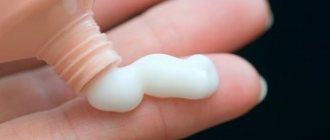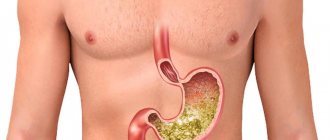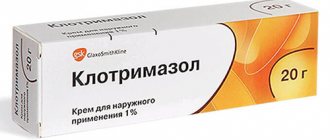April 27, 2020
Regular treatment with ointment is one of the mandatory methods of treating psoriasis on the arms, legs, face and other parts of the body. The oily texture of such external products allows the active ingredients to remain on the skin for a long time, which makes them more effective than creams and gels.
The list of ointments for psoriasis includes two main types of products:
- Hormonal. They can bring good results, but have many side effects.
- Non-hormonal. Less effective, but safer compared to hormonal ones.
Hormonal ointments for psoriasis
The active components of hormonal ointments are glucocorticosteroids - hormones that can suppress the activity of the immune system and reduce inflammation. Most often, such ointments contain the following components:
- Hydrocortisone: Laticort, Oxycort, Hydrocortisone.
- Triamcinolone: Triacort, Fluorocort.
- Betamethasone: Beloderm, Akriderm, Celestoderm.
- Clobetasol: Powercourt, Cloveit.
- Methylprednisolone: Campoderm, Advantan.
The only advantage of hormonal ointments is the rapid appearance of results. There are many more disadvantages, and these include:
- getting used to it over time;
- presence of withdrawal syndrome;
- serious side effects;
- impossibility of using long-term courses;
- influence on hormonal levels;
- risk of relapse after discontinuation of the drug.
Dermatologists do not recommend the use of hormonal ointments if more than 20% of the skin is affected. Also, do not apply them to areas of sensitive skin: in the neck, skin folds, face, areas of diaper rash. Such drugs cannot be used without a doctor's prescription, even if they are sold without a prescription. Due to uncontrolled use, the functioning of the adrenal glands may be disrupted, which will lead to serious problems and diseases.
Causes of psoriasis
The exact causes of psoriasis have not yet been identified. However, the most common are 2 theories of the origin of this disease:
- Hereditary disease – the tendency to develop psoriasis is believed to be passed on genetically.
- A consequence of immunity disorders caused by infections, poor lifestyle, climatic conditions, and bad habits.
Reference! In 40% of patients suffering from this pathology, relatives also suffered from psoriasis. Also, close relatives of patients often experienced a latent form of psoriasis, manifested by changes in the structure of capillaries.
Most often, the “push” to start the development of psoriasis is emotional overload (in 50% of cases), focal infections, metabolic disorders, diabetes mellitus, liver disease, and taking certain medications (most often glucocorticosteroids, beta-blockers, lithium salts).
There are other factors that “trigger” the disease or provoke its exacerbation:
- Injuries, fractures.
- Frostbite.
- Sunburn.
- Tobacco smoking.
- Alcohol abuse.
- Obesity.
- Damage to the skin by chemicals.
- Food allergies.
- Parasitic infestations.
- Pregnancy and childbirth.
- Other skin diseases - eczema, dermatitis.
Reference! It is absolutely known that psoriasis is not contagious. The development of pathology in people whose close relatives suffer from this disease is explained by genetic predisposition. Psoriasis is not transmitted from person to person.
Non-hormonal ointments for psoriasis
Non-hormonal agents are considered moderately effective and at the same time inexpensive ointments for psoriasis. Their advantages compared to hormonal ones include:
- relative safety;
- lack of addiction;
- lower cost;
- possibility of long-term use without harm to health;
- no serious side effects;
- preservation of hormonal levels;
- no load on the liver and kidneys;
But even with all the advantages, non-hormonal ointments for psoriasis cannot be called truly effective. Unlike hormonal ones, they have a much weaker effect. Their effect does not appear so quickly, so they are prescribed only for mild manifestations of psoriasis. They are also considered safer for the treatment of psoriasis in children.
Non-hormonal ointments eliminate peeling, swelling, itching, relieve inflammation and irritation. In addition, despite the safer composition, the use of such drugs does not exclude the development of an allergic reaction if a person is intolerant to one or another component.
Depending on the effect they provide, all non-hormonal ointments are divided into several categories:
- Others: ichthyol, cartolin, grease, tar, naphthalan. They have anti-inflammatory and antiseptic effects. But it must be borne in mind that such ointments are not recommended for the progressive stage of psoriasis and for large lesions. Tar ointment is contraindicated in phototherapy because it has a photosensitizing effect.
- Herbal medicines. This includes products based on sage, celandine, aloe, elecampane and other plant components. They are considered the safest of all non-hormonal ointments. But the plant base can cause allergic reactions.
- Keratolytics: zinc, salicylic, zinc-salicylic. Their main property is the exfoliation of dead cells, which in psoriasis do not have time to be rejected. Keratolytics can cause increased inflammatory reactions, a burning sensation, and increased pigmentation of surrounding healthy skin.
Moisturizing ointments are used as non-hormonal auxiliary agents for psoriasis. But they only help eliminate the feeling of dryness and tightness of the skin.
Features of non-hormonal ointments
Salicylic ointment for psoriasis is one of the most inexpensive, but it must be borne in mind that its action for such a serious disease is often insufficient. They show good exfoliating, softening and antiseptic effects, but like other non-hormonal ointments, they take at least 2 weeks to appear, and sometimes later.
The same can be said about the use of grease-based ointment for psoriasis. In addition, these are very specific products that have a pungent odor. It can stick to furniture and clothing and is very difficult to wash off.
Among the listed ointments there are no those for the use of which clinical trials have been conducted. This means that their effectiveness is only confirmed by the experience of some users. Clinical trials were carried out only on the following drugs:
- as Pimecrolimus (Elidel cream);
- Calcipotriol (Davonex);
- Zinc pyrithione (Zinocap).
This suggests that their use can indeed be beneficial. But Pimecrolimus, if used uncontrolled, has a risk of infection, and Calcipotriol should not be used if more than 30% of the skin surface is affected, as this can lead to hypercalcemia.
The only extremely safe remedy remains zinc pyrithione. Thus, answering the question of which ointment is best for psoriasis, we can say that Zinocap. But this does not negate the fact that its effect is still weaker than that of hormonal drugs.
Psoriasis and its treatment at home: effective and proven folk methods
There are different ways to combat the disease, but they usually involve the use of formulations based on the products that nature provides us.
Birch tar
It should be applied in its pure form to the plaques and washed off after 10-15 minutes under running warm water. After the procedure, the skin should be wiped with a clean towel and indifferent ointments should be applied. If foci of the disease are found in the scalp, then the tar must be removed within 5 minutes after application. The procedure is recommended to be carried out once every two days.
Kerosene
For truly effective treatment, you need to mix kerosene and nut extract. Take green walnuts and fill them with kerosene. Now we leave them for a month, after which you can start using the composition to heal wounds.
Hydrogen peroxide and soda
Experts recommend taking a bath with baking soda, which softens the plaques, and then treating the injured skin with hydrogen peroxide. This should be done twice a day. As a result, inflammation, itching is eliminated and the separation of scales is generally improved.
Brewer's yeast
Brewer's yeast can be used to activate metabolic processes and improve the patient's condition. They should be taken twice a day 35 minutes before meals. For an adult you will need one tablespoon, and for a child – a teaspoon.
Shevchenko mixture
To prepare it, you need to mix 30-40 ml of sunflower oil with the same amount of vodka. The container is tightly closed, after which it must be shaken vigorously for five minutes. The prepared mixture should be drunk in one go.
Burnt alum
They look like a white powder, which is obtained by exposing potassium alum sulfate to high temperature. The composition is used as a powder. It relieves inflammation, dries wounds and stops bleeding.
Living and dead water
First you need to wash your skin with soap and then steam it with a hot compressor. Next, the skin is moistened with dead water. After 15 minutes, the injured areas of the skin are watered with live water. For the next five days you need to use exceptional living water. The procedure is carried out up to eight times a day. In total, the patient will have to undergo five courses, between which there is a break of one week.
Silver water
You need to place silver in water and leave it there for a day. In the future, you should take a bath with the resulting infusion. For greater effect, you can also add silicon to the water. The duration of the procedure is one hour. After taking a bath, wipe your skin with pollen from the puffball mushroom and wash off after 1.5 hours. The procedure must be carried out every day for ten days.
Celandine
This is an effective folk method of treating psoriasis, which, according to reviews, is quite effective. Celandine can be used as an ointment or prepared as an herbal bath. Our ancestors also noticed that this is an effective remedy in the fight against psoriasis. This is actually what determines the name of the plant. Take a tablespoon of celandine juice and mix it with 4 liters of boiling water. The bath temperature should be within 40 degrees, and the patient needs to stay in it for 10 minutes. The main thing is to keep the proportion correctly, otherwise you will worsen the situation.
Aloe
Aloe can be used to treat psoriasis. All you need to do is wipe the areas of inflamed skin with aloe juice or prepare a bath with it. Mix aloe juice, calamus root, flaxseed oil and celandine in equal proportions. Pour boiling water over the ingredients, then mix and pour into the bath.
Propolis and honey
This is a popular way to combat the disease. The beneficial effects of bee products on the body have been known to man since time immemorial. You just need to dilute a glass of honey in a hot bath to minimize the symptoms of the disease in 10-15 minutes of bathing. You can use a more complex recipe. 100 grams of honey are mixed with 2 tablespoons of jojoba oil and a liter of milk. Take this bath twice a week for 30 minutes. From propolis you can prepare an ointment that is applied to the plaques. To do this, mix 50 grams of propolis and 500 grams of butter.
Lotions with egg
A raw egg is mixed with a tablespoon of vinegar and melted butter. The ingredients are thoroughly mixed, after which they are put in the refrigerator for a week. After letting the composition brew, apply it to the plaques six times a day.
Bay leaf decoction
To prepare it, you need to take seven medium-sized bay leaves, which should be brewed in two tablespoons of boiling water. Let the mixture simmer on the fire for 10 minutes. The resulting broth should be filtered. The resulting medicine is drunk in the morning and evening, half a glass, for seven days. This is a simple and effective method of treating the disease.
Which ointment to choose
Only a professional dermatologist should decide which ointment to treat psoriasis. His task is to choose the safest and at the same time effective drug. For more than 25 years, the PsorMak clinic has been practicing treatment with ointment against psoriasis, made according to the original recipe. There are no hormonal components in the composition, which provides the product with the following advantages:
- Possibility of use by children and pregnant women;
- absence of withdrawal and addiction syndrome;
- mild impact without provoking relapses;
- no contraindications.
But our specialists understand that even the most effective ointment for the treatment of psoriasis must be suitable for the patient. Therefore, before prescribing, we make sure to conduct a complete diagnosis.
In addition, an integrated approach is important in the treatment of psoriasis.
In this regard, our dermatologists develop an individual diet for the patient, and, if necessary, provide a referral for acupuncture and psychotherapy. If you want to achieve a long-term relapse and stop struggling with unpleasant symptoms every day, sign up for a consultation at PsorMac and we will select an individual treatment regimen for you. April 27, 2020
Author of the article: dermatologist Mak Vladimir Fedorovich
Types and stages of psoriasis
There are many forms of psoriasis, but some are the most common:
- Ordinary psoriasis develops most often. It is characterized by the presence of itchy plaques with a scaly surface on the skin. Also, with this form, discoloration of the nails and the appearance of small white spots on them are often observed. In some cases (in advanced stages), the nails move away from the nail bed.
- Guttate psoriasis manifests itself as a small rash localized mainly on the chest and back. The rash is accompanied by itching in areas where the skin is affected. Usually the symptoms of the disease disappear after 4-6 months and no longer appear. However, the patient may subsequently develop another form of psoriasis. This happens about half the time. Guttate psoriasis is usually seen in children and adolescents. It often develops as a result of infection, most often after a bacterial infection of the throat.
- Reversible psoriasis responds well to treatment, and sometimes it is possible to achieve stable remission without relapses. Red, weeping plaques appear only in some parts of the body, in the folds, and do not spread further. Typically, rashes appear in the groin area or under the mammary glands, also in the armpits. Reversible psoriasis most often develops in older patients.
- Pustular psoriasis is a severe and dangerous form. In some cases it develops rapidly and suddenly. It is characterized by the appearance of blisters with purulent contents on the soles and palms, then the affected skin thickens and begins to actively peel off. Later, the rash spreads over large areas. In advanced cases, the skin of the entire body may be affected. Pustular psoriasis can threaten the patient's life. Affects mainly adults.
Psoriasis develops in 3 stages:
- Progressive.
- Stationary.
- Regressive.
The progressive stage is characterized by the appearance of multiple nodular rashes and their spread to new areas of the body. The plaques gradually increase in size.
During the stationary stage, the appearance of rashes stops. The existing plaques stop increasing in size, but active peeling begins over the entire affected surface.
In the regressing stage , the plaques become denser, their elements dissolve, and peeling decreases. Then, at the site of the rash, spots devoid of pigment remain.
Reference! Psoriasis can also be classified according to seasonality: there are summer and winter forms, according to the development of exacerbations. Most often, relapses occur more often in the autumn-winter period than in the spring-summer period.
Photo of psoriasis on the face, what psoriasis looks like on the face
Photo 1. Psoriasis on the face.
Photo 2. Psoriasis of the scalp.
Photo 3. Seborrheic psoriasis of the face.
Photo 4. Psoriasis on the skin of the face.
Psoriasis on the face in the initial stage may resemble simple dermatitis; for comparison, just look at the photo on a medical website. In order to get acquainted with what classic psoriasis looks like on the face, it is recommended to familiarize yourself with the photo.
Treatment of psoriasis
The main goal of medical measures is not to cure the patient (since this is impossible), but to achieve stable remission. Comprehensive treatment is carried out, the plan of which is developed in accordance with the course of the disease in a particular person. It includes:
- Local drug therapy - ointments, creams, shampoos, aerosols, lotions.
- General drug therapy - injections of antihistamines, sedatives, vitamins, treatment with immunosuppressants, cytostatics, retinoids, corticosteroid hormones.
- Maintenance therapy - the patient is prescribed ultraviolet irradiation together with methoxsalen.
- The use of detoxification methods - the appointment of immunomodulators, procedures that cleanse the blood.
- In some cases, taking non-steroidal anti-inflammatory drugs.
If concomitant diseases are diagnosed, they are also treated.
Symptoms of psoriasis
Symptoms of psoriasis are:
- Pink rashes or white patches covered with scales.
- Itching in the affected areas.
- Vascular changes.
- Signs of inflammation in affected tissues.
- Deterioration in the appearance and condition of nails.
Reference! About 1 in 10 patients develop arthritis as a result of psoriasis. Therefore, it is necessary to start treatment as early as possible to prevent the development of complications.
Prevention of psoriasis on the face
Preventive measures are aimed at preventing the development of the disease or the transition of psoriasis from remission to the acute stage. They imply adherence to a daily routine and rest, proper and balanced nutrition, giving up bad habits, and eliminating stress factors.
Basic criteria for caring for delicate facial skin:
- wash only with special moisturizers;
- water at a comfortable temperature (30-36°C);
- soak the remaining moisture with a soft towel;
- the use of creams that protect against cold and ultraviolet rays;
- wearing clothes (outerwear with a hood, scarf) and accessories according to the season (use an umbrella in rain and wind);
- Men are recommended to use an electric razor.
Compliance with preventive measures and timely therapy prescribed by a specialist will reduce the risk of spread and relapse of the disease.








